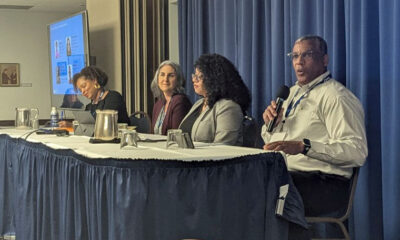Thrive
New helicopter, chickens help prevent local mosquito viruses

Mosquitoes are one of Florida’s unavoidable nuisances, like humidity and exorbitant insurance rates; however, 17 of the 40 species that call Pinellas County home can also pose serious health risks.
Pinellas County officials shed some light on the local fight against the blood-sucking pests Tuesday as the summer rainy season is now in full swing. Alissa Berro, director of mosquito control and vegetation management, said all 40 species begin their life in as little as a capful of water.
Berro’s department provides mosquito treatment and prevention services throughout Pinellas, including its 24 municipalities. She noted that recent rains “definitely make it easier” for larvae to flourish.
“But don’t be fooled because even during times where we don’t have that much water in the environment, mosquitoes are really good at finding places to breed,” Berro added. “Some of those locations can be our tidal areas … as well as places like your own yard.”

Alissa Berro, director of mosquito control and vegetation management, said county traps feature a “stinky feet smell” that attracts the pests.
Berro said mosquitoes that carry malaria typically avoid residential areas. However, local species that transmit Zika and dengue viruses “love to live in areas around your home.”
The Centers for Disease Control (CDC) reports that many people infected with Zika will not show symptoms and those who do typically have mild fevers, rashes, and joint pain. The virus is significantly more dangerous among pregnant women, as it can cause birth defects and other complications.
Dengue can cause severe fever, bleeding, a sudden drop in blood pressure and, in the most serious cases, death. There is no treatment. Berro said those species have stripes and a propensity for biting human ankles.
Brooke Walter, epidemiologist for the Florida Department of Health (DOH) in Pinellas County, said now is the “busiest time of year for mosquito activity.” She noted bites can also cause encephalitis, which results in brain swelling.
The county is doing its part to prevent mosquito-borne diseases – and the associated inability to enjoy the outdoors. Officials have a long-awaited new helicopter to drop granular larvicide, typically biological agents like specific soil bacteria and Methoprene, around difficult-to-reach and vast breeding habitats.
A new Airbus H125 helicopter will drop the larvicide on immature mosquitoes before they become problematic adults. It replaces a 1967 Bell TH 13T helicopter, similar to the model popularized in the classic TV series M*A*S*H.
“Our new helicopter also has the ability to carry four times the amount of products that our previous helicopter is able to use,” Berro said. “So, it makes us far more efficient.
“That’s huge … and all that technology helps make us more efficient, more accurate, but it also means we have a big job to do in terms of learning the new equipment and being safe for our community.”

The county also utilizes “sentinel chickens” to help prevent mosquito-borne illness outbreaks.
The county also has a decidedly less sophisticated resource in its fight against mosquitoes – sentinel chickens. Berro’s department partners with the local DOH to monitor eight coops spread throughout Pinellas.
DOH tests the chickens’ blood for mosquito-borne virus antibodies. The feathered sentinels serve as an early warning system for outbreaks, and officials have not received any positive reports this year.
Berro said carbon dioxide released when exhaling attracts mosquitoes. While studies suggest they prefer certain blood types, she said the “human bouquet” has more appeal.
“That’s why this is a stinky feet type of scent,” Berro said of the lures in over 57 county traps. “Because it’s going to bring in the mosquitoes that really like to bite people. This one is particularly helpful when we’re worried about disease factors.”
She explained that problematic mosquitoes typically only fly about five houses away from their birthplace. Residents can help control the population by dumping standing water once weekly, including in oft-overlooked areas, like children’s toys and flowerpots.
Berro said loose-fitting, light-colored clothing with long sleeves and pants will mitigate bites. She also encouraged using repellants with CDC-recommended active ingredients. “Even oil of lemon eucalyptus is a wonderful alternative that is just as effective,” she added.
However, Walter noted that the best way to avoid mosquitoes is to stay indoors during dusk and dawn. Berro said the pests also provide ecological benefits as pollinators.







